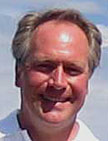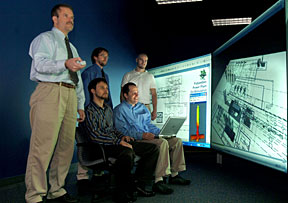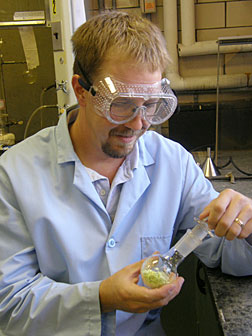| Research
|
Mark Wanlass' twist on the design of multi-layered solar cells created a new type of device capable of out performing all others in efficiency. By using several layers of semiconductor, multi-junction solar cells are capable of record-breaking efficiency in converting sunlight to electricity and maintaining a high efficiency under great concentrations of solar energy. Wanlass, a researcher at DOE¹s National Renewable Energy Laboratory, has been working on multi-junction solar cells since 1980. Conventional multi-junction cells are grown from the bottom up, starting with germanium and transitioning to higher-band-gap III-V materials for the top layers, leaving the cell bound to the thick, heavy germanium substrate it grew out of. Wanlass suggested the cell be grown upside down so the germanium substrate can be removed, reducing thickness, weight and cost. Wanlass' design also incorporates lattice-mismatched materials, which he developed extensively while researching thermophotovoltaic (electricity directly from heat) technology for nearly 15 years. Typically the atoms in a multi-junction cell are evenly spaced, which generally results in superior electrical performance. But with mismatched materials, the atoms are unevenly spaced, giving designers more materials to choose from to create even higher-efficiency solar cells. The overall result is a better multi-junction solar cell with higher performance. "The inverted multi-junction solar cell is really the crown jewel of my career," Wanlass said. "It is very rewarding to have had a hand in something that is having an actual impact on the commercial side of solar." Wanlass has spent his career looking to create a better solar cell. After earning his bachelor¹s degree at Cornell University in 1979, Wanlass began working as a full-time researcher at NREL. Since then, he has earned his masters in physics from the Colorado School of Mines and his doctorate from the University of Wales . "I was in it for the long haul," he said.Submitted by DOE's
National Renewable |
|||||||||||||||||||||||
|
Check out the joint Fermilab/SLAC publication symmetry.
|
NETL researchers develop new material for CO2 adsorption
Researchers at DOE's National Energy Technology Laboratory (NETL) are always seeking answers in their quest to safely and economically capture greenhouse gases. The development of a new material for the adsorption of carbon dioxide (CO2) has taken them one step further toward this goal. The new adsorbent, developed by NETL researcher Jeff Culp, is a unique member of the latest class of materials called metal organic frameworks (MOFs) and is a flexible pillared-layered compound. The pillars are a specially chosen organic compound and the layers consist of sheets of nickel cyanide. Together they are inter-layered to create a series of open channels that can accommodate gas molecules. When CO2 is not present, the pillars are tilted and the structure is partially collapsed; however, as CO2 is adsorbed into the structure, the pillars “stand at attention,” the channels open up, and more gas molecules are captured. The behavior of the MOF is very unusual in that it displays dramatic structural changes when exposed to varying degrees of pressure. Most adsorbents used to capture gases are rigid; they simply fill with increasing pressure and empty with decreasing pressure. When the MOF is filled with CO2, a certain threshold pressure is required to force the structure open. Pressure can be released once the structure is full, yet it retains the CO2 until pressure levels are minimal. Unlike rigid structures, the adsorbent then returns to its previous relaxed state. The flexible nature of the structure depends on the exact structure of the pillar, which can be controlled by NETL researchers. Brad Bockrath, a physical scientist with the Chemistry and Surface Science Division, points out that this degree of control is a great advance in adsorption science and “opens up new doors for novel materials that will improve the capture or separation of carbon dioxide.” Publication of the findings is expected early next year. Submitted by DOE's
National Energy |



